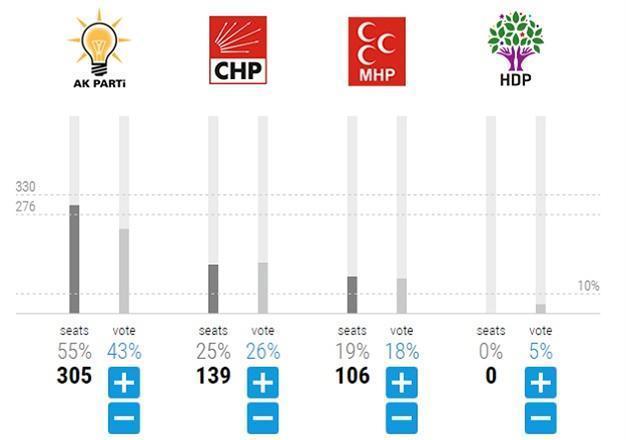INTERACTIVE: Simulator for Turkey's upcoming general elections

This still image shows the ready distrubution for 2014 Local Elections. An interactive tool for different distrubutions is below.
Many countries, including Turkey, use the D’Hondt method in their elections to allocate parliamentary seats to parties. Although the D’Hondt itself is a proportional method, the electoral threshold of 10% employed in the Turkish elections can have dramatic effects on which parties are represented in the general assembly and with how many seats. Thus, the discussion of alternative scenarios based on whether the Peoples' Democracy Party (HDP) stays above the threshold or not has become commonplace in both traditional and social media.
With this tool, we attempt to simulate the possible seat allocations given the national vote distributions of the political parties. Because the election method allocates seats at electoral district levels, it is impossible to compute the precise seat allocations with the national votes. We need to come up with approximations:
To deal with this issue, we assume each party’s vote distribution across electoral districts stays the same as the previous elections. For example, if the ruling Justice and Development Party (Ak Parti) received 2% of its votes from Manisa in 2011, we allocate 2% of the predicted votes in 2015 to Manisa. We do the same for other parties for Manisa and apply the D’Hondt method to estimate the seat allocations for this city. We repeat this procedure for all electoral districts and we get the national estimates for the seat allocations.
For Ak Parti, the main opposition Republican People's Party (CHP), and the Nationalist Movement Party (MHP) we used their electoral-level distributions in the 2011 Turkish General Elections. For HDP we used the electoral-level distribution of the votes for Selahattin Demirtaş (co-chair of HDP and the presidential candidate in 2014) in the 2014 Turkish Presidential Elections.
TRY YOURSELF:
A couple of notes about the results: Based on the above (underlying) assumptions, the simulator lets us see the dramatic changes in the seat allocations based on whether HDP stays above the threshold or not. Similarly, when we assign equal votes to the four main parties, we observe that Ak Parti receives more seats than the others. The reason is a combination of two factors:
1) Even if the national votes are equal, our assumptions dictate that the votes of the parties are not always equal within districts.
2) Districts have unequal representation with respect to the number of electors. The seats are assigned to the districts based on the general population, not the number of voters. According to the 2011 vote distributions, these factors favor Ak Parti.
As an example of the unequal representation, the contrast between İzmir and Bayburt is striking: İzmir is one of the cities that have the fewest representatives per voter (1 representative per 119.000 voters). Bayburt is one of the cities that have the most representatives per voter (1 representative for 27.000 voters).
